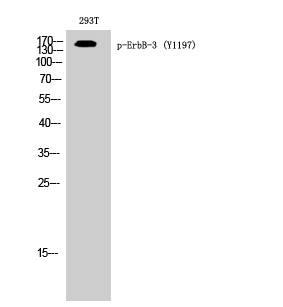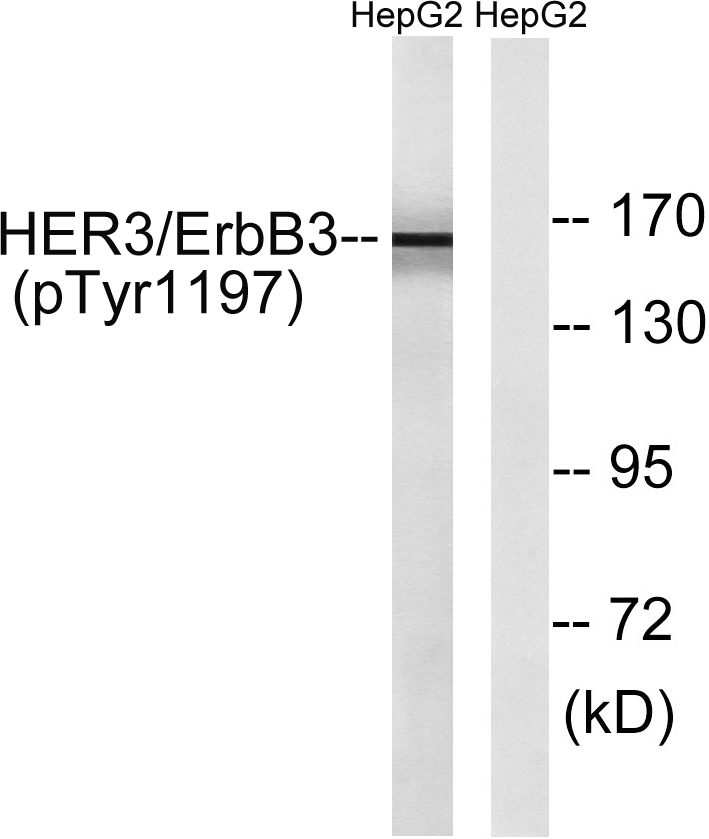ErbB-3 (phospho Tyr1197) Polyclonal Antibody
- Catalog No.:YP0482
- Applications:WB;ELISA
- Reactivity:Human;Mouse;Rat
- Target:
- ErbB-3/her2
- Fields:
- >>EGFR tyrosine kinase inhibitor resistance;>>MAPK signaling pathway;>>ErbB signaling pathway;>>Calcium signaling pathway;>>PI3K-Akt signaling pathway;>>Proteoglycans in cancer;>>MicroRNAs in cancer
- Gene Name:
- ERBB3
- Protein Name:
- Receptor tyrosine-protein kinase erbB-3
- Human Gene Id:
- 2065
- Human Swiss Prot No:
- P21860
- Mouse Gene Id:
- 13867
- Mouse Swiss Prot No:
- Q61526
- Rat Gene Id:
- 29496
- Rat Swiss Prot No:
- Q62799
- Immunogen:
- The antiserum was produced against synthesized peptide derived from human HER3 around the phosphorylation site of Tyr1197. AA range:1163-1212
- Specificity:
- Phospho-ErbB-3 (Y1197) Polyclonal Antibody detects endogenous levels of ErbB-3 protein only when phosphorylated at Y1197.
- Formulation:
- Liquid in PBS containing 50% glycerol, 0.5% BSA and 0.02% sodium azide.
- Source:
- Polyclonal, Rabbit,IgG
- Dilution:
- WB 1:500 - 1:2000. ELISA: 1:40000. Not yet tested in other applications.
- Purification:
- The antibody was affinity-purified from rabbit antiserum by affinity-chromatography using epitope-specific immunogen.
- Concentration:
- 1 mg/ml
- Storage Stability:
- -15°C to -25°C/1 year(Do not lower than -25°C)
- Other Name:
- ERBB3;HER3;Receptor tyrosine-protein kinase erbB-3;Proto-oncogene-like protein c-ErbB-3;Tyrosine kinase-type cell surface receptor HER3
- Observed Band(KD):
- 160-170kD
- Background:
- This gene encodes a member of the epidermal growth factor receptor (EGFR) family of receptor tyrosine kinases. This membrane-bound protein has a neuregulin binding domain but not an active kinase domain. It therefore can bind this ligand but not convey the signal into the cell through protein phosphorylation. However, it does form heterodimers with other EGF receptor family members which do have kinase activity. Heterodimerization leads to the activation of pathways which lead to cell proliferation or differentiation. Amplification of this gene and/or overexpression of its protein have been reported in numerous cancers, including prostate, bladder, and breast tumors. Alternate transcriptional splice variants encoding different isoforms have been characterized. One isoform lacks the intermembrane region and is secreted outside the cell. This form acts to modulate the activity of the m
- Function:
- catalytic activity:ATP + a [protein]-L-tyrosine = ADP + a [protein]-L-tyrosine phosphate.,disease:Defects in ERBB3 are the cause of lethal congenital contracture syndrome type 2 (LCCS2) [MIM:607598]; also called Israeli Bedouin multiple contracture syndrome type A. LCCS2 is an autosomal recessive neurogenic form of a neonatally lethal arthrogryposis that is associated with atrophy of the anterior horn of the spinal cord. The LCCS2 syndrome is characterized by multiple joint contractures, anterior horn atrophy in the spinal cord, and a unique feature of a markedly distended urinary bladder. The phenotype suggests a spinal cord neuropathic etiology.,disease:Overexpressed in a subset of human mammary tumors.,domain:The cytoplasmic part of the receptor may interact with the SH2 or SH3 domains of many signal-transducing proteins.,function:Binds and is activated by neuregulins and NTAK.,PTM:Li
- Subcellular Location:
- [Isoform 1]: Cell membrane ; Single-pass type I membrane protein.; [Isoform 2]: Secreted.
- Expression:
- Epithelial tissues and brain.
- June 19-2018
- WESTERN IMMUNOBLOTTING PROTOCOL
- June 19-2018
- IMMUNOHISTOCHEMISTRY-PARAFFIN PROTOCOL
- June 19-2018
- IMMUNOFLUORESCENCE PROTOCOL
- September 08-2020
- FLOW-CYTOMEYRT-PROTOCOL
- May 20-2022
- Cell-Based ELISA│解您多样本WB检测之困扰
- July 13-2018
- CELL-BASED-ELISA-PROTOCOL-FOR-ACETYL-PROTEIN
- July 13-2018
- CELL-BASED-ELISA-PROTOCOL-FOR-PHOSPHO-PROTEIN
- July 13-2018
- Antibody-FAQs
- Products Images

- Western Blot analysis of 293T cells using Phospho-ErbB-3 (Y1197) Polyclonal Antibody diluted at 1:500 cells nucleus extracted by Minute TM Cytoplasmic and Nuclear Fractionation kit (SC-003,Inventbiotech,MN,USA).

- Western blot analysis of lysates from HepG2 cells , using HER3 (Phospho-Tyr1197) Antibody. The lane on the right is blocked with the phospho peptide.



